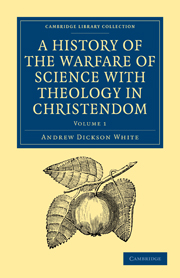Book contents
- Frontmatter
- INTRODUCTION
- Contents
- CHAPTER I FROM CREATION TO EVOLUTION
- CHAPTER II GEOGRAPHY
- CHAPTER III ASTRONOMY
- CHAPTER IV FROM “SIGNS AND WONDERS” TO LAW IN THE HEAVENS
- CHAPTER V FROM GENESIS TO GEOLOGY
- CHAPTER VI THE ANTIQUITY OF MAN, EGYPTOLOGY, AND ASSYRIOLOGY
- CHAPTER VII THE ANTIQUITY OF MAN AND PREHISTORIC ARCHÆOLOGY
- CHAPTER VIII THE “FALL OF MAN” AND ANTHROPOLOGY
- CHAPTER IX THE “FALL OF MAN” AND ETHNOLOGY
- CHAPTER X THE “FALL OF MAN” AND HISTORY
- CHAPTER XI FROM “THE PRINCE OF THE POWER OF THE AIR” TO METEOROLOGY
- CHAPTER XII FROM MAGIC TO CHEMISTRY AND PHYSICS
CHAPTER XI - FROM “THE PRINCE OF THE POWER OF THE AIR” TO METEOROLOGY
Published online by Cambridge University Press: 29 August 2010
- Frontmatter
- INTRODUCTION
- Contents
- CHAPTER I FROM CREATION TO EVOLUTION
- CHAPTER II GEOGRAPHY
- CHAPTER III ASTRONOMY
- CHAPTER IV FROM “SIGNS AND WONDERS” TO LAW IN THE HEAVENS
- CHAPTER V FROM GENESIS TO GEOLOGY
- CHAPTER VI THE ANTIQUITY OF MAN, EGYPTOLOGY, AND ASSYRIOLOGY
- CHAPTER VII THE ANTIQUITY OF MAN AND PREHISTORIC ARCHÆOLOGY
- CHAPTER VIII THE “FALL OF MAN” AND ANTHROPOLOGY
- CHAPTER IX THE “FALL OF MAN” AND ETHNOLOGY
- CHAPTER X THE “FALL OF MAN” AND HISTORY
- CHAPTER XI FROM “THE PRINCE OF THE POWER OF THE AIR” TO METEOROLOGY
- CHAPTER XII FROM MAGIC TO CHEMISTRY AND PHYSICS
Summary
GROWTH OF A THEOLOGICAL THEORY
The popular beliefs of classic antiquity regarding storms, thunder, and lightning, took shape in myths representing Vulcan as forging thunderbolts, Jupiter as flinging them at his enemies, Æolus intrusting the winds in a bag to Æneas, and the like. An attempt at their further theological development is seen in the Pythagorean statement that lightnings are intended to terrify the damned in Tartarus.
But at a very early period we see the beginning of a scientific view. In Greece, the Ionic philosophers held that such phenomena are obedient to law. Plato, Aristotle, and many lesser lights, attempted to account for them on natural grounds; and their explanations, though crude, were based upon observation and thought. In Rome, Lucretius, Seneca, Pliny, and others, inadequate as their statements were, implanted at least the germs of a science. But, as the Christian Church rose to power, this evolution was checked; the new leaders of thought found, in the Scriptures recognized by them as sacred, the basis for a new view, or rather for a modification of the old view.
This ending of a scientific evolution based upon observation and reason, and this beginning of a sacred science based upon the letter of Scripture and on theology, are seen in the utterances of various fathers in the early Church.
- Type
- Chapter
- Information
- A History of the Warfare of Science with Theology in Christendom , pp. 323 - 372Publisher: Cambridge University PressPrint publication year: 2009First published in: 1896



